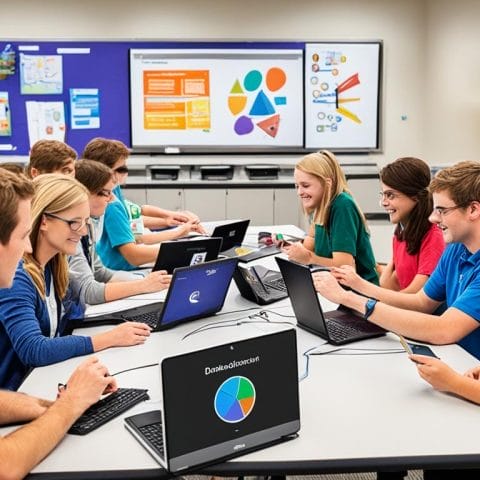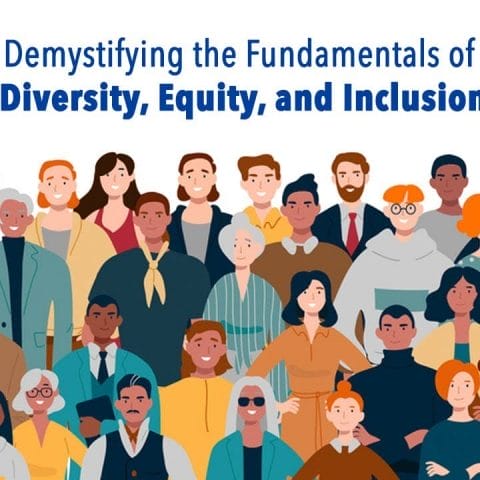Did you know that over 70% of educators believe AI can boost student performance? This shows how AI is changing education for the better. It combines traditional teaching with online learning, making AI key for customizing education for each student.
Companies like Hyperspace are creating AI tools to improve blended learning. These tools help with keeping students interested and managing the curriculum. AI is not just an extra tool; it’s vital for changing how students learn and interact with their lessons.
Key Takeaways
- Artificial intelligence is pivotal for enhancing blended learning outcomes.
- AI technologies create personalized learning experiences for students.
- Integrating AI tools can address common challenges in education.
- Blended learning combines traditional methods with innovative online practices.
- Companies like Hyperspace are leading the charge with AI-driven solutions.
- Effective use of AI can lead to improved student engagement and performance.
Introduction to Blended Learning
Blended learning is a new way to teach that mixes traditional classes with online learning. It uses different teaching methods to fit various learning styles. This approach lets students learn at their own speed and in ways that work best for them.
Blended learning technology is becoming a key part of education. It makes learning more engaging and helps students remember more. With the help of AI, hybrid learning is getting even better, making education available to everyone.
After the COVID-19 pandemic, schools started using hybrid learning more often. This method offers great online learning options. It ensures students get a full education without missing out. By combining classroom and online learning, everyone involved can do their best.
The Rise of Artificial Intelligence in Education
Artificial intelligence has changed how we learn. Schools now use machine learning in online education to make learning more personal. This change lets teachers spend more time teaching and less on paperwork.
AI makes learning fit each student’s needs, making it more engaging and effective. Teachers can now give feedback right away, thanks to real-time data analysis. This new approach combines online and in-person learning to improve education.
| AI Application | Description | Benefits |
|---|---|---|
| Adaptive Learning | Customized learning experiences based on individual student needs. | Improved retention and understanding of material. |
| Intelligent Tutoring Systems | AI-based platforms that provide personalized support. | Increased student engagement and motivation. |
| Learning Analytics | Analysis of student data to inform teaching strategies. | Data-driven insights leading to better academic outcomes. |
AI has huge potential in education, offering new ways to learn. It promises to change education for the better, helping students of all backgrounds and learning styles. Learn more about how AI is changing education here.
Artificial Intelligence in Blended Learning
Artificial intelligence changes the game in blended learning for both students and teachers. It makes learning personal by tailoring it to each student’s needs. With AI, students get learning materials that change as they progress, making their education unique.
Personalized Learning Experiences
AI helps students by looking at what they’re good at and where they need help. It finds out what they don’t know and changes lessons to fill those gaps. Teachers use AI to pick the best reading materials and activities for each student.
This way, students stay interested and motivated to move forward in their studies.
Real-time Feedback and Support
AI also gives students feedback and help right when they need it. Teachers can easily check how students are doing and what they understand. AI tools give teachers insights into how students learn best.
Teachers can quickly help students who are struggling. This makes learning more flexible and supportive for everyone.
Improving Engagement with AI-Driven Tools

AI in education makes learning more engaging by offering tools that meet each student’s needs. These tools make classes more interactive and keep students interested. They help students connect better with the material they’re learning.
The Role of ChatGPT in Education
ChatGPT is a key example of how AI changes education. It acts as a personal assistant, offering one-on-one help and quick feedback. This makes students more motivated and active in class.
With ChatGPT, teachers can make learning fun and keep students interested. It helps students stay focused and want to learn more.
Gamification and Interactive Learning
Gamification makes learning more engaging in blended classrooms. It uses game elements like competition and rewards to make learning fun. This approach makes classes more exciting and helps students do better.
AI tools track how students are doing and adjust the lessons for them. This ensures each student has a learning experience that fits their needs. Gamification also helps students work together and succeed.
Adaptive Learning Technologies
Adaptive learning technologies are changing education with *adaptive learning with artificial intelligence*. They make learning fit each student’s way of learning and speed. This means learning is more personal. Instead of the same lesson for everyone, these systems change based on how students do, making learning just right for them.
These platforms use algorithms to look at student data and make learning paths just for them. This lets students move through subjects at their own pace. It helps them remember and understand better. The main features of adaptive learning technologies are:
- Dynamic Content Adjustment: Content changes based on how students interact and do on tests.
- Predictive Analytics: Uses past data to guess how students will do and adjusts the level of difficulty.
- Individual Learning Goals: Sets goals based on how well students have done before.
With *adaptive learning with artificial intelligence*, students are more involved in their learning. They get feedback quickly to fix any mistakes. This makes learning not just better but also more enjoyable and rewarding.
Sustainable Education Through AI Integration
Using AI in education brings many benefits, especially for sustainable learning. Moving to digital platforms makes learning better and helps the environment too.
Environmental Benefits of Reduced Materials
AI technologies lead to using less material. Old ways of teaching use a lot of paper, which harms forests and creates waste. Going digital helps schools:
- Use less paper, which means fewer trees cut down.
- Produce less waste, which ends up in landfills.
- Use less energy for making and sending out textbooks and materials.
AI also makes school work easier and less wasteful. This means less paper and less waste from old ways of doing things. Schools using AI are helping the planet and teaching the importance of caring for the earth.
Adding AI to education is a smart move that makes learning green. As schools use these new tools, they help the planet and improve learning. This is a big step towards a better future.
Challenges of Implementing AI in Blended Learning
Adding AI to blended learning brings many challenges for teachers and schools. These include issues with making learning accessible to everyone and keeping data safe and private. It’s key to tackle these problems to make sure all students can learn equally well.
Accessibility and Equity Issues
Many AI tools need good internet and modern devices to work well. But, not all students have these things. This means some students can’t use AI tools, which is a big problem in blended learning. We need to make sure every student has the technology they need to use AI in school.
Data Privacy and Security Concerns
AI uses a lot of student data to work. Schools must handle this data carefully to keep it safe. If they don’t, students might not trust AI in education. So, it’s important to have strong security to protect student data and use AI responsibly.
| Challenges | Impact on Learning | Proposed Solutions |
|---|---|---|
| Accessibility Issues | Limited engagement with AI resources | Investment in technology for underserved communities |
| Equity Concerns | Disparities in learning outcomes | Develop programs focused on equitable access |
| Data Privacy | Risk of data breaches | Implement strict data protection policies |
| Security Threats | Loss of trust among stakeholders | Regular audits of data security measures |
Future Directions for AI in Education

The future of AI in education looks bright, with big changes on the horizon. New technologies will bring tools that make learning more personal and flexible. This will change how students interact with their lessons.
Educators and schools will start using AI more in their systems. This will make learning better by offering paths that fit each student’s needs. It will also make students more engaged and help them do better in school. Keeping up with new research and updates will be key to using AI fully.
Here are some areas that will see big changes:
- Personalized Learning: Tailoring educational experiences to meet individual student needs and preferences.
- Adaptive Assessments: Utilizing AI to develop assessments that respond in real-time to student performance.
- Intelligent Tutoring Systems: Offering real-time, interactive feedback and support tailored to individual learners.
These changes could really change things for the better. Schools could become places where every student can succeed. AI will help meet the unique needs of each learner.
| Feature | Traditional Learning | AI-Enhanced Learning |
|---|---|---|
| Personalization | Limited customization | Tailored learning experiences |
| Feedback | Delayed feedback | Real-time feedback |
| Assessment | Standardized testing | Adaptive testing based on performance |
In summary, AI is bringing a new era to education. It’s making learning more dynamic and responsive. Schools that adopt these new technologies will be key to success in the future.
Conclusion
Artificial intelligence is changing how we teach and learn. It makes learning more personal for each student. This change helps students stay engaged and succeed better.
AI helps solve old problems in education, like not having enough resources and keeping students interested. For more details, check out this in-depth review on how AI boosts learning through blended models.
We need to keep moving forward with AI in education. It can make learning fair and open for everyone. The future of education is exciting, and the changes could be huge.
FAQ
How does artificial intelligence enhance blended learning?
Artificial intelligence makes learning more personal. It gives students real-time feedback and support. It also makes learning more fun and suited to each student’s needs.
What is blended learning?
Blended learning mixes traditional classroom learning with online parts. This approach offers more flexibility and suits different learning styles.
How is AI transforming education?
AI changes education by making learning paths more personal. It uses interactive tools to keep students engaged. It also helps teachers with administrative tasks, making education more efficient.
What role does machine learning play in online education?
Machine learning is key in online learning. It looks at how students perform and adjusts learning to fit their pace. It offers customized learning experiences.
How does AI provide personalized learning experiences?
AI uses data to make learning more personal. It changes lesson content and suggests resources based on how students do. It also adjusts the pace of learning.
What tools improve student engagement in blended learning?
Tools like ChatGPT and gamification make learning more engaging. They give students instant feedback and create a fun, competitive atmosphere.
What are adaptive learning technologies?
Adaptive learning technologies use AI to change content to match how students learn best. They make sure students face the right challenges at the right time.
How does AI contribute to sustainable education?
AI helps make education more eco-friendly. It uses digital resources, cuts down on paper, and reduces waste. This supports green practices in schools.
What challenges exist regarding AI implementation in education?
Using AI in schools faces challenges like unequal access to technology. This can affect how students learn. There are also worries about keeping student data safe and private.
What is the future of AI in education?
The future of AI in education looks bright. We’ll see more integrated systems that make learning personal, engaging, and effective. New technologies and innovations will drive these changes.





